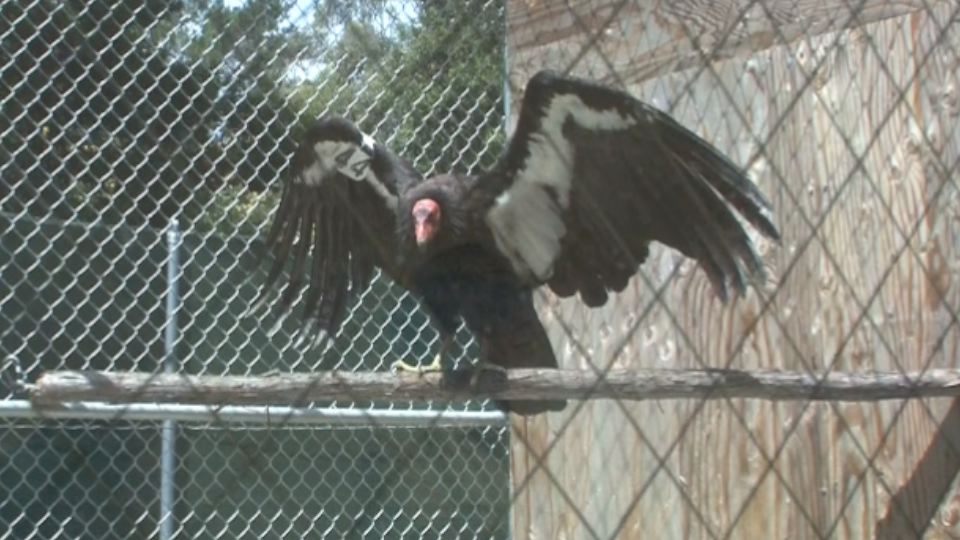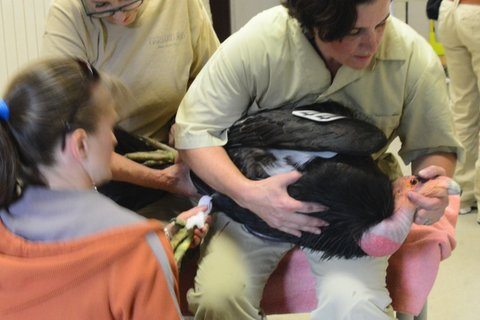Treating condors for lead at the Oakland Zoo
By Holly Bern
I’d be thrilled to announce that a healthy condor had made its way into the East Bay, but, alas, it is a sick bird that has come to the Oakland Zoo to be treated for lead poisoning.
On May 1, the Oakland Zoo received its first California Condor as part of the Condor Recovery Program, in partnership with the Ventana Wildlife Society, Los Angeles Zoo, San Diego Zoo, and Pinnacles National Park. Until now, condors from the Central California area that became ill had to travel to the Los Angeles Zoo to receive treatment. The Oakland Zoo is several hours closer, and for sick birds that difference could be crucial.
For several years, the zoo has been acquiring special permits to handle and treat the endangered birds. They have built an enclosure and treatment center that can house as many as 6 to 8 birds. The facility is not a part of the main zoo and is not open to the public. Because the birds are wild and the goal is to re-release them, it is important to keep them from having too much human contact and exposure. Zoo veterinarians have made many trips down to the L.A. Zoo to learn the special techniques that are required to treat these birds.

Although captive breeding has succeeded at increasing their numbers since they nearly went extinct, California Condors struggle to survive as they are released back into the wild. What began in 1987 as a group of 27 condors has grown to a population of over 400 birds with more than half of those individuals now in the wild.
Wild condors now fly freely in California, Utah, Arizona, and Baja California. Mortality due to lead poisoning is thought to be the chief obstacle to their recovery. As scavengers, condors occasionally feed on carcasses that have been shot with lead ammunition. Lead ammunition has been banned within condor habitat since 2008, but compliance is not 100 percent and it takes only a small piece of lead to severely poison a bird. The birds can also range hundreds of miles and may fly beyond the reaches of the ammunition restrictions. Governor Jerry Brown signed legislation last year that will ban lead ammunition throughout all of California, but this will not go into full effect until 2019.
Condors are highly social birds whose feeding and other activities are based on a hierarchy of dominance. Scientists who work with the condors believe that the more dominant birds may be most affected by consumption of lead in scavenged animals. The dominant birds are first to eat, and they may go straight to the wound channel as a way to easily access flesh. In an animal shot with a lead projectile, this channel and the surrounding area may be rife with toxic fragments.
The dominant birds in a flock tend to be older birds that are of breeding age, so it is particularly unfortunate that at a time when they could potentially help repopulate the species, they often suffer from elevated lead levels. Few birds are making it into their teens or beyond, even though the potential life span of condors is thought to be 50 to 60 years.
Scientists with the Condor Recovery Program are optimistic that lead may become less of a threat for the birds as the statewide ban goes into effect and as awareness of the issue increases, but this is still a few years off. Until lead is eliminated from the environment, they will continue to trap and test birds for lead about twice a year.
During a recent condor round-up in Pinnacles National Park, bird #444 tested high, and biologists and veterinarians concurred that she should be sent to the Oakland Zoo for treatment.
Dr. Andrea Goodnight, the veterinarian at the Oakland Zoo heading the Condor project, described receiving #444, also known as Ventana, as a bittersweet moment — sweet, because of the zoo’s eagerness to participate in condor recovery, but bitter because any bird arriving for treatment is a sick one.

Dr. Goodnight was struck by the intelligence of Ventana and the other condors with which she has worked. You can see Ventana being brought into the Oakland Zoo for her treatment: http://youtu.be/OvDTeuVkmjE.
Ventana is considered a special bird, a wild-raised chick from the Central California flock that has mated with a bird from the Pinnacles flock (her mate, #340, was coincidentally spotted by the GGBA group on their Birdathon trip to Pinnacles on April 26).
The pair nested and produced an egg last year that failed to hatch. The pair looked like they might nest again this spring, but Condor Recovery workers believe that Ventana’s lead poisoning could be interfering with her mating. Breeding pairs like Ventana and #340 represent the best hope for the species to become self-sustaining. Whenever one member of a breeding pair falls ill, it is especially disheartening.
During Ventana’s stay at the Oakland Zoo, she has been receiving five daily injections of a chelating agent, Ca-EDTA, which works by binding to lead in the blood and then allowing its excretion. When her lead levels come down sufficiently, she will be transported back to Pinnacles and released.
About a week after Ventana’s arrival, the Oakland Zoo received a second condor — this one a three-year-old male identified as #602. After one round of treatment, 602 was ready to return to Pinnacles. Ventana’s lead levels have also been decreasing, but not yet enough for release: she began a third round of treatment on Friday.
“Once we have have some more handling experience with two birds, we will likely take some more birds,” said Dr. Goodnight. “Of course, we hope that we won’t have more to treat, but it looks like the lead is here (for) now.”
Let’s hope that Ventana makes a speedy recovery and will head home soon to Pinnacles. Until then, they can be seen on the Zoo’s Condor Cam: http://www.oaklandzoo.org/Condor_Cam.php?cam=Oakland_Zoo
————————————
Golden Gate Bird Alliance member Holly Bern is smitten with California Condors. She has a soft spot for plenty of other animals too, including owls, pelicans, sandhill cranes, hummingbirds, penguins, whale sharks, parrotfish, platypuses, vizslas, her mom, her husband and her two boys.
